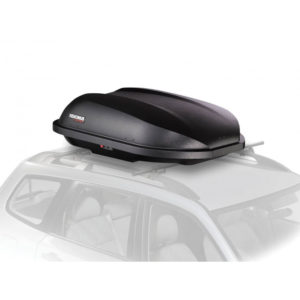

Installation is a piece of cake and requires no tools. The Pro 11 is advertised as a box perfect for skis and snowboards, but it is equally appropriate for paddles and PFDs. In go the paddles, the life jackets, a dry bag or two, and off you go to the put-in. At 2-feet wide, it fits with even a tandem canoe on 66-inch bars, and still opens easily. A narrow cargo box that fits on top of the rack next to the canoe or kayak, that opens with the boat in place, and that accommodates all that pokey, bulky, hard-to-contain gear. Actually, many smaller cars have surprising cargo space, but it’s the riff-raff that defeats the packing strategy – paddles, PFDs, bailers, small dry bags, all that essential stuff that tends to rattle around loose in the load. So much for taking friends, or keeping the gear explosion down to something below 7.0 on the Richter scale every time you open the back hatch. But then everything else gets crammed in the car. Yes, rack manufacturers have come up with all manner of ingenious rigs for hauling boats on mini vehicles. Still, there are less expensive options out there that suit that description as well.Ruby Kesselheim loading the car for a canoe getaway in warmer climes. $649 buys you the one and only cargo box you may ever need, assuming you don’t crash your car or run into a low-ceiling garage. However, the rear overhang would likely prevent the hatch from opening completely.īecause of the box’s relatively high profile, I could sense my van struggling to reach highway speeds from a stop. For example rails on a Subaru Outback have a max capacity of 150 pounds, which equates to a 98-pound load limit for the Skybox.ĭue to its super-long length, the Skybox Pro 18 would look ridiculous on small hatchbacks or sloping rear window type vehicles (although the Skybox’s 24” minimum crossbar spread would work on those vehicles).

Yakima is reluctant to provide a max weight capacity on the box since the max capacity of a car’s rails determines how much weight can be stuffed in the box. It’s a cargo monster.Īt 92 x 36 x 16 inches 5 inches, it’ll suck up a van’s worth of snow gear. It easily swallowed my snowboard, skis and boots and from eye balling it, I’m positive that I could’ve fit 4 sets of skis/poles with 2 snowboards layered on top thanks to the Skybox Pro’s 16-inch height. Removal, however, beats the Thule at less than 2 minutes.Īs stated above, the Skybox shines in terms of a clean cargo space inside that maximizing available space. I suspect that after setting the clamps’ position, I’d save around 2 minutes in installation time. I spent 10 minutes positioning the hooks to fit my crossbars and tighten them down. Yakima’s rack attachment hardware isn’t as quick as Thule’s, but the quick-release system is nearly as simple. It slipped and dropped onto my driveway, which scratched the Yakima’s gorgeous onyx-black top. This was even more apparent when I removed the box from the top of my minivan. It’s really a two-man operation since the box is so much more cumbersome than either the Thule or the Rola tested here. I was able to throw the Skybox onto my roof by myself, but it wasn’t easy. The Yakima was the burliest construction of the models tested this season (Winter 2013)-that equates to more stiffness, which translates into easier opening and closing/locking. It would’ve been nice to access the closed box without the key, or do away with the lever, which sticks out from the side of the box and will affect airflow. The locking mechanism uses a lever to open, but it felt redundant since you can’t open the box with out the key anyway. Tie-down clamps line either side of the box’s floor and a standard cargo next will hold tight anything. The Skybox comes with a pad that fit between the rack attachment hardware inside and protects ski and snowboard edges from cutting the box’s floor. Start with a quick-release clamp attachment (think, bike wheel) that cinches tight in a split second and doesn’t stick up into the cargo space like Thule’s does. However, it’s inside the box where this box shines. The Skybox Pro won’t win any awards for aerodynamic design: it follows Yakima’s aesthetic that’s been relatively unchanged for over a decade.


 0 kommentar(er)
0 kommentar(er)
